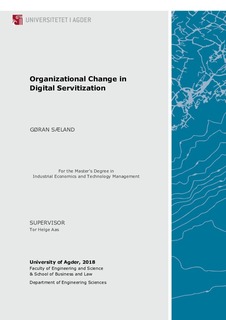| dc.description.abstract | Recent changes in markets where customers are demanding more customisation, flexibility, freedom of choice, and instant response; manufacturers and other organizations seek to become more service-oriented and customer-centric for the purpose of recognising and realising product-service offerings, which will enable them to meet the needs of customers with greater capabilities. The process of becoming more service-oriented and customer-centric have been termed servitization, where recent advancements in digital technologies and the rise of Internet-of-Things have lead researchers to acknowledge the importance of embedding technology in product-service systems. This acknowledgement has brought the concept of digital servitization to life where more emphasis on digital technology is present. Digital servitization was first introduced in 2015 and has therefore just recently gained the attention of researchers; where the process of digital servitization, what digital technologies utilised in this regard, and how they are utilised, are yet to be explored.
This study seeks to explore how organizations change when implementing a digital servitization strategy, and what digital technologies could be deployed to aid this process and enhance future product-service offerings. The following research is based on an abductive approach which implies that both deductive and inductive approaches are utilised, with more emphasis on the latter. It has been conducted with the qualitative method of multiple case-study where five manufacturers and two IT consultant agencies were interviewed.
My findings indicate that these companies are increasing their focus on leveraging data. They seek to establish more sources for gathering data both internally and externally by emphasising a digital ecosystem; and engage in collaborative partnerships with other players in this ecosystem to accomplish greater capabilities in the leverage of data. A culture of sharing and receiving data will have to be mutual for all collaborators. Processes are to be as efficient as possible for allowing data to be transmitted and managed in real-time, where a strong digital infrastructure must be present for this to be possible. By establishing a single digital system, or platform which will consist of all the data, could allow for more complex digital services to be identified and developed; where digital technologies such as blockchains, digital twins, EHF, AI, IoT, AR, and VR are elements that could improve their capability in recognising and realising these services. The importance of a new way of thinking are highlighted due to opportunities in digital technologies being limited only by imagination. The findings in this study could help organizations to better implement a digital servitization strategy. | nb_NO |

